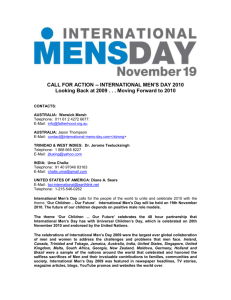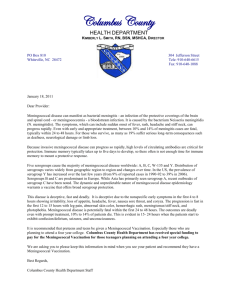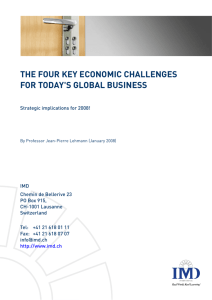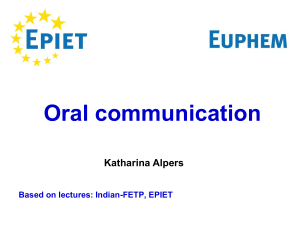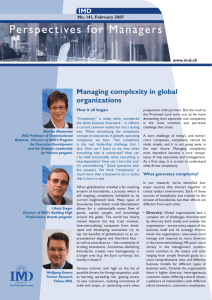Annual Report of the Australian Meningococcal Surveillance
advertisement
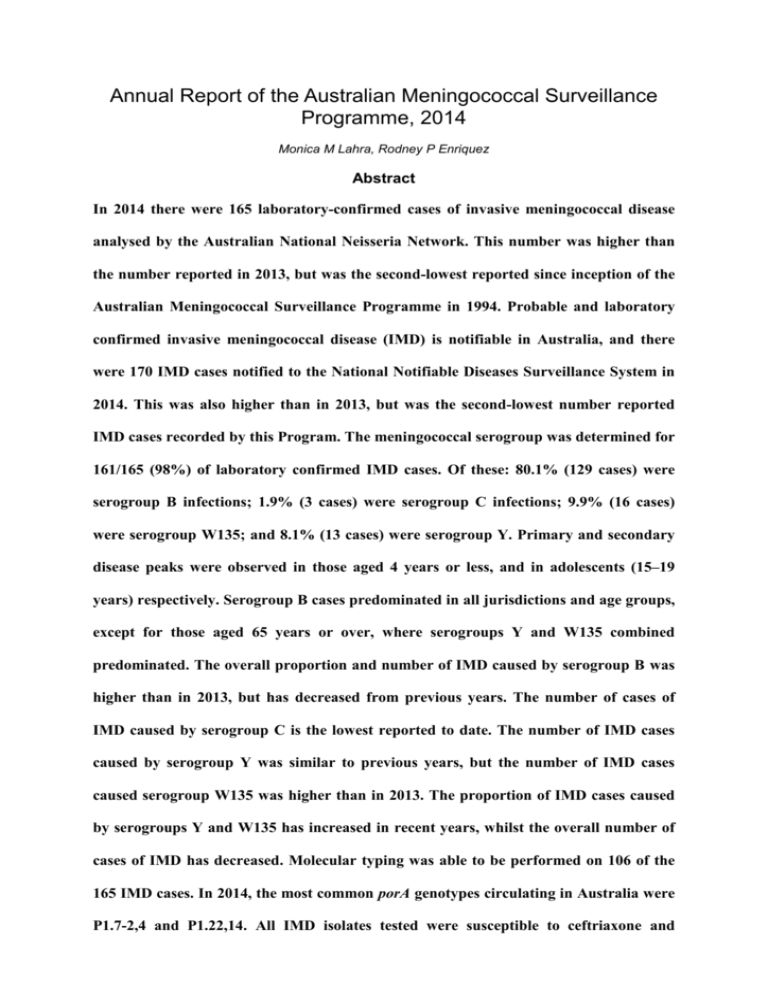
Annual Report of the Australian Meningococcal Surveillance Programme, 2014 Monica M Lahra, Rodney P Enriquez Abstract In 2014 there were 165 laboratory-confirmed cases of invasive meningococcal disease analysed by the Australian National Neisseria Network. This number was higher than the number reported in 2013, but was the second-lowest reported since inception of the Australian Meningococcal Surveillance Programme in 1994. Probable and laboratory confirmed invasive meningococcal disease (IMD) is notifiable in Australia, and there were 170 IMD cases notified to the National Notifiable Diseases Surveillance System in 2014. This was also higher than in 2013, but was the second-lowest number reported IMD cases recorded by this Program. The meningococcal serogroup was determined for 161/165 (98%) of laboratory confirmed IMD cases. Of these: 80.1% (129 cases) were serogroup B infections; 1.9% (3 cases) were serogroup C infections; 9.9% (16 cases) were serogroup W135; and 8.1% (13 cases) were serogroup Y. Primary and secondary disease peaks were observed in those aged 4 years or less, and in adolescents (15–19 years) respectively. Serogroup B cases predominated in all jurisdictions and age groups, except for those aged 65 years or over, where serogroups Y and W135 combined predominated. The overall proportion and number of IMD caused by serogroup B was higher than in 2013, but has decreased from previous years. The number of cases of IMD caused by serogroup C is the lowest reported to date. The number of IMD cases caused by serogroup Y was similar to previous years, but the number of IMD cases caused serogroup W135 was higher than in 2013. The proportion of IMD cases caused by serogroups Y and W135 has increased in recent years, whilst the overall number of cases of IMD has decreased. Molecular typing was able to be performed on 106 of the 165 IMD cases. In 2014, the most common porA genotypes circulating in Australia were P1.7-2,4 and P1.22,14. All IMD isolates tested were susceptible to ceftriaxone and ciprofloxacin. There were two isolates that were resistant to rifampicin. Decreased susceptibility to penicillin was observed in 88% of isolates. Keywords: antibiotic resistance; disease surveillance; meningococcal disease; Neisseria meningitidis Introduction The Australian National Neisseria Network (NNN) is a collaborative network of reference laboratories in each state and territory that contribute to the laboratory surveillance system of the pathogenic Neisseria species (N. meningitidis and N. gonorrhoeae). Since 1994 the NNN has coordinated laboratory data from the examination of N. meningitidis cases of invasive meningococcal disease (IMD) for the Australian Meningococcal Surveillance Programm2e (AMSP). (1) The AMSP is funded by the Australian Government Department of Health. Participating NNN laboratories supply phenotypic and genotypic data on invasive meningococci for the AMSP. These data supplement the notification data from the National Notifiable Diseases Surveillance System (NNDSS), which includes cases of probable IMD as well as laboratory confirmed IMD. The characteristics of meningococci responsible for IMD and the associated demographic information are important considerations for management of individual patients and their contacts. These data also inform public health responses for outbreaks or case clusters, locally and nationally. The introduction of the publicly funded conjugate serogroup C meningococcal vaccine onto the National Immunisation Program in 2003 has seen a significant and sustained reduction in the number of cases of serogroup C IMD after 2003.(2) However, IMD remains an issue of public health concern in Australia. Methods Case confirmation of invasive meningococcal disease Case confirmation is based on isolation of N. meningitidis, or a positive nucleic acid amplification testing (NAAT) from a normally sterile site, defined as laboratory definitive evidence of IMD by the Communicable Diseases Network Australia criteria.(3) Information regarding the site of infection, age and sex of the patients is collated by the NNN for the AMSP. IMD cases are categorised on the basis of the site from which N. meningitidis was isolated, or from which meningococcal DNA was detected. When N. meningitidis is grown from blood only, the IMD case is classified as septicaemia; cerebrospinal fluid (CSF) only cultures are classified as meningitis. When N. meningitidis is grown from both blood and cerebrospinal fluid (CSF) cultures from the same patient, the case is classified as one of meningitis. Phenotyping and genotyping of Neisseria meningitidis Phenotyping is limited to the determination of the serogroup by detection of soluble polysaccharide antigens. Genotyping of both isolates and DNA extracts is performed by sequencing of products derived from amplification of the porin genes porA, porB and FetA. Antibiotic susceptibility testing Isolates were tested to determine their minimum inhibitory concentration (MIC) values to antibiotics used for therapeutic and prophylactic purposes: ceftriaxone, ciprofloxacin; rifampicin. This program uses the following parameters to define the various levels of penicillin susceptibility or resistance when determined by a standardised agar plate dilution technique: (4) These are: Sensitive (MIC ≤ 0.03 mg/L); Less Sensitive (MIC 0.06–0.5 mg/L) and Resistant (MIC ≥ 1 mg/L). Results In 2014, there were 165 laboratory-confirmed cases of IMD analysed by the NNN, and 170 cases notified to the NNDSS. Thus, laboratory data were available for 97% of notified cases of IMD in Australia in 2014 (Figure 1). This is the second-lowest annual number of IMD cases recorded by the NNDSS, and by the AMSP (In 2013, there were 149 IMD cases recorded by NNDSS, 143 laboratory confirmed IMD cases reported by the AMSP). As in previous years, the peak incidence for IMD was in late winter and early spring (1 July to 30 September) (Table 1). Table 1: Laboratory confirmed cases of invasive meningococcal disease, Australia, 2014, by quarter Serogroup 1 January– 31 March 1 April– 30 June 1 July– 30 September 1 October– 31 December 2014 Total B 20 29 45 35 129 C 2 0 1 0 3 Y 0 7 3 3 13 W135 4 3 4 5 16 NG 0 0 0 0 0 ND 0 2 0 2 4 Total 26 41 53 45 165 (NG: non groupable; ND: not determined) Figure 1: Number of invasive meningococcal disease cases reported to the National Notifiable Diseases Surveillance System compared with laboratory confirmed data from the Australian Meningococcal Surveillance Programme, Australia, 2014 In 2014, the highest number of laboratory confirmed cases was from Queensland (39 cases), which was higher than that reported in this state in 2013 (32 cases). Other states that recorded a rise in IMD cases in 2014 compared with 2013 were: Victoria (33 cases in 2014, compared with 23 in 2013), and South Australia (31 cases in 2014, compared with 21 in 2013). By contrast, New South Wales recorded a fall in the number of IMD cases in 2014 (36 cases) compared with 2013 (43 cases). Numbers for the other states were similar to 2013 (Table 2). Table 2: Number of laboratory confirmed cases of invasive meningococcal disease, Australia, 2014, by state or territory and serogroup Serogroup State or territory B C Y W135 NG ND Total ACT 1 0 1 0 0 0 2 NSW 21 0 8 6 0 1 36 NT 4 0 0 0 0 0 4 Qld 31 1 2 3 0 2 39 SA 31 0 0 0 0 0 31 Tas. 1 0 0 1 0 0 2 Vic. 27 0 1 4 0 1 33 WA 13 2 1 2 0 0 18 Australia 129 3 13 16 0 4 165 78.2 1.8 7.9 9.7 0 2.4 % (NG: non groupable; ND: not determined). Age distribution Nationally, the peak number of IMD cases was in children less than 5 years of age, similar to previous years. Between 2007 and 2013, 28% to 36% of cases were in this age group. In 2014, 46/165 (28%) IMD cases occurred in this age group (Table 3). A secondary disease peak has also been observed in previous years amongst adolescents aged 15 to 19 years. Of the total cases of IMD, 30/165 (18%) were in those aged 15 to 19 years in 2014, which was the same as the proportion reported for 2013; and similar to the proportion reported in this age group during the period 2007 to 2011 (17% to 20%). The proportion of IMD cases in those aged 25 to 44 (14.5%, 24 cases) was almost double than that in 2013 (7.7%, 11 cases). Table 3: Laboratory confirmed cases of invasive meningococcal disease, Australia, 2014, by age and serogroup Age group Serogroup <1 1–4 5–9 10–14 15–19 20–24 25–44 45–64 65+ NS Total B 24 16 8 5 22 20 13 12 7 2 129 C 1 1 0 0 0 1 0 0 0 0 3 Y 1 0 0 0 2 1 1 1 7 0 13 W135 2 0 0 1 5 1 0 2 5 0 16 NG 0 0 0 0 0 0 0 0 0 0 0 ND 1 0 0 0 1 1 1 0 0 0 4 Total 29 17 8 6 30 24 15 15 19 2 165 82.8 94.1 100.0 83.3 73.3 83.3 86.7 80.0 36.8 % B of within age group (NS: age not stated; NG: non groupable: ND not determined) Anatomical site of samples and method of confirmation In 2014, diagnosis was made by a positive culture in 95/165 (58%) cases and, 70/165 (42%) cases were confirmed by NAAT testing (Table 4). There were 58 diagnoses of meningitis based on cultures or NAAT examination of CSF either alone or with a positive blood sample. There were 103 diagnoses of septicaemia based on cultures or NAAT examination from blood samples alone (Table 4). There were 4 IMD diagnoses by positive joint fluid culture (n=2) and NAAT (n=2). Table 4: Number of laboratory confirmed cases of invasive meningococcal disease, Australia, 2014, by anatomical source and method of confirmation Specimen type Bacterial culture NAAT Total Blood 69 34 103 CSF +/– blood 24 34 58 Other‡ 2 2 4 Total 95 70 165 NAAT: nucleic acid amplification testing; CSF = cerebrospinal fluid. Serogroup data Number of cases of invasive meningococcal disease by serogroup B, C, Y, W135 The serogroup was determined for 161 of 165 laboratory confirmed cases of IMD in 2014 (Tables 2 and 3). There has been an overall decrease in the number of cases of IMD in Australia in recent years, which was initially predominantly due to a reduction in the number of cases of IMD caused by serogroup C from 2003 to 2007. This was followed by a decline in the numbers IMD cases caused by serogroup B from 194 cases in 2009, to 104 cases in 2013. In 2014, there was an increase in the numbers of IMD cases caused by serogroup B (n=129). The number of cases of IMD caused by serogroup Y has remained stable since 2011, whereas, the number of cases of serogroup W135 IMD has increased in recent years (7 to 16 cases in 2011 to 2014, compared with 4 to 9 cases in 2007 to 2010). In 2014 there were 16 cases, the highest number ever reported by the AMSP. Proportions of serogroup B, C, Y, W135 invasive meningococcal disease Of the 161 IMD strains for which the serogroup was determined, 80.1% were serogroup B, which was higher than in 2013 (74.8%), but lower than that reported in the years 2006 to 2012 (84% to 88%). The proportion of cases of IMD caused by serogroup B in children less than 5 years in 2014 was lower than in previous years (2008 to 2013) (Table 3, Figure 2). However, in young adults 20–24 years, the number of cases of serogroup B IMD in 2014 was higher than in 2007 to 2011 and 2013 (61% to 67%), and similar to 2012. The proportion of cases of IMD caused by serogroup B in those aged 15–19 has remained relatively stable since 2008, but was lower in 2014. Serogroup B IMD was prominent in IMD in all age groups excepting 65 years or more where, serogroup Y was equally prevalent, and serogroup W135 slightly less so,. Figure 2: Number of serogroup B and C cases of confirmed invasive meningococcal disease, Australia, 2014, by age group The number and proportion of IMD caused by serogroup C in 2014 was lowest since the inception of the Australian Meningococcal Surveillance Programme (1.9% and the number was?). Two of the three cases of IMD caused by serogroup C in 2014 were in those aged less than 20 years in 2014, compared with 1 case in 2013, 2 cases in 2012 and no cases in 2011 in this age group. Of note, coincident with the decline in serogroup C IMD, the proportion of IMD caused by serogroups Y and W135 has been increasing in recent years. In 2012 to 2014 serogroup Y accounted for 7.7% to 10.8% of IMD, higher than the proportion reported in the period 2007 to 2011: 3.5% to 5.0%. Similarly the proportion by serogroup W135 IMD was 8.6% to 9.9% of IMD in 2013 to 2014, higher than the 1.8% to 4.5% reported in the period 2007 to 2011. The number and proportion of IMD cases caused by serogroup Y was highest in people aged 65 years or over in 2014. The number and proportion of IMD cases caused by serogroup W135 was highest in people aged 65 years or over, and also in people aged 15–19 years. Genotyping In 2014, genotyping was performed for 106/165 (64%) IMD cases (Tables 5 and 6). The predominant porA genotypes for serogroup B IMD cases were again P1.7-2,4 (14 cases) and P1.22,14 (14 cases). Other porA genotypes for serogroup B IMD cases more frequently seen in 2014 were P1.7,16-26 (7 cases); and P1.18-1,34 and P1.22,9 (6 cases each) The AMSP was not aware of any epidemiological link between any of the cases reported where genotyping was available. Table 5: Laboratory confirmed cases of invasive meningococcal disease, Australia, 2014, by porA gentoype 2014 AMSP Genotype PorA Number per serogroup Total B C W135 Y P1.5,2 9 0 0 9 0 P1.5-1,10-1 8 1 0 1 6 P1.5-1,10-4 5 1 0 1 3 P1.5-1,10-46 2 1 0 0 1 P1.5-1,10-8 2 0 2 0 0 P1.5-1,2-2 1 0 0 0 1 P1.5-1,2-52 1 1 0 0 0 P1.5-2,10-1 1 0 0 0 1 P1.5-2,2 1 0 1 0 0 P1.7,16-26 7 7 0 0 0 P1.7,16-44 2 2 0 0 0 P1.7,30 1 1 0 0 0 P1.7,30-3 1 1 0 0 0 P1.7-1,10-27 1 1 0 0 0 P1.7-2,4 14 14 0 0 0 P1.7-2,16-26 2 2 0 0 0 P1.12-6,13-13 1 1 0 0 0 P1.17,16-3 1 1 0 0 0 P1.18-1,3 6 3 0 3 0 P1.18-1,3-8 3 3 0 0 0 P1.18-1,30 1 1 0 0 0 P1.18-1,34 6 6 0 0 0 P1.19,15 1 1 0 0 0 P1.19-1,15-11 1 1 0 0 0 P1.19-1,26 1 1 0 0 0 P1.19-2,13-1 1 1 0 0 0 2014 AMSP Genotype PorA Number per serogroup Total B C W135 Y P1.22,9 6 6 0 0 0 P1.22,14 14 14 0 0 0 P1.22,14-6 3 3 0 0 0 P1.22,14-22 1 1 0 0 0 P1.22,26-8 1 1 0 0 0 P1.22-1,14 1 1 0 0 0 106 77 3 14 12 Total Table 6: Distribution of porA genotype laboratory confirmed cases of invasive meningococcal disease, Australia, 2014, by state or territory 2014 AMSP Genotype PorA P1.5,2 Number per serogroup per state NSW Qld Vic. 2 W135 2 W135 2 W135 P1.5-1,10-1 6 Y,1 W135 P1.5-1,10-4 1 W135 SA 2 W135 1Y 1Y Tas. NT 2 W135 1Y 1B 1B 1Y P1.5-1,10-8 2C P1.5-1,2-2 1Y P1.5-1,2-52 1B P1.5-2,10-1 1Y P1.5-2,2 1C P1.7,16-26 3B 3B P1.7,16-44 1B 1B 1B P1.7,30 1B P1.7,30-3 1B P1.7-1,10-27 1B 1B P1.7-2,16-26 7B 4B 1B 1B P1.12-6,13-13 1B 1B P1.17,16-3 1B P1.18-1,3 1 W135 3 B, 2 W135 P1.18-1,3-8 3B P1.18-1,30 1B P1.18-1,34 4B P1.19,15 P1.19-1,15-11 ACT 1B P1.5-1,10-46 P1.7-2,4 WA 1B 1B 1B 1B 1B 2014 AMSP Genotype PorA Number per serogroup per state NSW Qld P1.19-1,26 Vic. SA WA ACT Tas. NT 1B P1.19-2,13-1 1B P1.22,9 2B 4B P1.22,14 2B 5B P1.22,14-6 2B 1B P1.22,14-22 1B P1.22,26-8 P1.22-1,14 3B 4B 1B 1B Figure 3: Number of porA genotypes (where data available) for serogroup B in cases of invasive meningococcal disease Australia, 2014 Antibiotic susceptibility testing Testing for antimicrobial susceptibility was performed for 95/165 (58%) of the IMD cases in 2014. All isolates tested were susceptible to ceftriaxone and ciprofloxacin. There were two isolates that were resistant to rifampicin. Using the defined criteria, 11/95 (11.6%) isolates were fully sensitive to penicillin (MIC 0.03 mg/L or less), and 84 (88%) isolates were less sensitive to penicillin (MIC=0.06– 0.5 mg/L). No isolates were resistant to penicillin. The proportion of strains less sensitive to penicillin was the highest recorded by the AMSP. Discussion In 2014, there were 165 cases of laboratory confirmed IMD, representing 97% of the number of notifications to the NNDSS.(2) This is both the second lowest number of cases reported since laboratory based surveillance for confirmed IMD cases (AMSP) began in 1994, and since notification data collection commenced in 1991. This represents less than one-third of the number reported in Australia in 2002 (n=580), when IMD rates peaked in Australia. The introduction of the serogroup C vaccine to the national immunisation schedule in 2003 has led to a steady decline in the total number of both serogroup C, and the overall number of cases of IMD. The primary peak in IMD infection continues to be in children less than 5 years, as reported in previous years, with a secondary peak in adolescents. The majority of IMD cases in Australia are caused by serogroup B. The proportion and number of IMD cases caused by serogroup C was lowest reported by the AMSP since the beginning of the program. The number of IMD cases caused by serogroup Y was similar to previous years. The number and proportion of cases caused by serogroup W135 was the highest reported by the AMSP. The proportion of IMD cases caused by serogroups Y and W135 has increased in recent years, coincident with the overall reduction in numbers of IMD cases, and are the predominant serogroups causing IMD in those aged 65 years or older. As in previous years, genotypic data found no evidence of a substantial number of cases of IMD caused by N. meningitidis that have undergone genetic recombination. There have been concerns that the emergence of new and invasive subtypes following extensive vaccine use would occur given the capacity for genetic recombination within meningococci.(5) Therefore the monitoring of meningococcal genotypes is an important part of the NNN program. All isolates were susceptible to ceftriaxone and ciprofloxacin; whilst there were two IMD isolates that were resistant to rifampicin. The proportion of IMD isolates with penicillin MIC values in the less sensitive category in 2014 was 88%, and was the highest proportion recorded by the AMSP. In previous years the range was 62% to 75% in 1996 to 2006; 67% to 79% in 2007 to 2009; and 78% to 85% in 2010 to 2013. Thus indicating a right shift in penicillin MIC values of IMD isolates, however, in Australia, the incidence of penicillin resistance in N. meningitidis is very low. In early 2014, a recombinant multi-component meningococcal B vaccine became available in Australia.(6) This vaccine is not on the immunisation register but is available for purchase privately. Therefore uptake is elective and the impact of its introduction is yet to be determined in this country. The AMSP continues to monitor the phenotypic and genotypic features of N. meningitidis causing IMD to inform treatment protocols and monitor prevention strategies. Acknowledgements Meningococcal isolates were received in the reference centres from many laboratories throughout Australia. The considerable time and effort involved in forwarding these isolates is recognised and these efforts are greatly appreciated. These data could not have been provided without this assistance and the help of clinical colleagues and public health personnel. The Australian Government Department of Health provided funding for the National Neisseria Network. Members of the AMSP in 2014 were: John Bates, Helen Smith and Vicki Hicks, Public Health Microbiology, Queensland Health Scientific Services, Coopers Plains, Queensland; Monica Lahra, Rodney Enriquez; Tiffany Hogan; Ratan Kundu and Athena Limnios, Department of Microbiology, SEALS, The Prince of Wales Hospital, Randwick, New South Wales; Dr Michael Maley, Robert Porritt and Joanne Mercer, Department of Microbiology and Infectious Diseases, SSWPS, Liverpool, New South Wales; Kerrie Stevens and Angelo Zaia, The Microbiological Diagnostic Unit Public Health Laboratory, Department of Microbiology and Immunology, University of Melbourne, Parkville, Victoria; Andrew Lawrence, Microbiology and Infectious Diseases Department, SA Pathology at Women’s and Children’s Hospital, North Adelaide SA, South Australia; Jane Bew, Leanne Sammels and Tony Keil, Department of Microbiology, Princess Margaret Hospital for Children, Subiaco, Western Australia; Belinda McEwan Belinda Chamley and Dr McGregor Department of Microbiology and Infectious Diseases, Royal Hobart Hospital, Hobart, Tasmania; Rob Baird, Kevin Freeman and microbiology staff, Microbiology Laboratory, Royal Darwin Hospital, Casuarina, Northern Territory; Angelique Clyde-Smith and Peter Collignon, Microbiology Department, Canberra Hospital, Garran, Australian Capital Territory. Participants in the 2014 AMSP to whom isolates and samples should be referred, and enquiries directed, are listed below. Australian Capital Territory P Collignon, S Bradbury, A Clyde-Smith Microbiology Department The Canberra Hospital Yamba Drive Garran ACT 2605 Telephone: +61 2 6244 2414 Email: peter.collignon@act.gov.au New South Wales MM Lahra, RP Enriquez, EA Limnios, TR Hogan, RL Kundu Microbiology Department, SEALS, The Prince of Wales Hospital Barker Street, Randwick NSW 2031 Telephone: +61 2 9382 9079 Facsimile: +61 2 9382 9310 Email: monica.lahra@sesiahs.health.nsw.gov.au M Maley, J Mercer, R Porritt Department of Microbiology and Infectious Diseases SSWPS Locked Mail Bag 7090 Liverpool BC NSW 1871 Telephone: +61 8738 5124 Facsimile: +61 2 8738 5129 Email: Joanne.Mercer@sswahs.nsw.gov.au or Robert.Porritt@sswahs.nsw.gov.au Northern Territory R Baird, K Freeman Microbiology Laboratory Northern Territory Government Pathology Service Royal Darwin Hospital Tiwi NT 0810 Telephone: +61 8 8922 8167 Facsimile: +61 8 8922 7788 Email: rob.baird@nt.gov.au Queensland J Bates, H Smith, V Hicks Public Health Microbiology Queensland Health Scientific Services 39 Kessels Road Coopers Plains Qld 4108 Telephone: +61 7 3274 9101 Facsimile: +61 7 3274 9175 Email: john_bates@health.qld.gov.au South Australia A Lawrence Microbiology and Infectious Diseases Department SA Pathology at Women's and Children's Hospital 72 King William Road North Adelaide SA 5006 Telephone: +61 8 8161 6376 Facsimile: +61 8 8161 6051 Email: andrew.lawrence@health.sa.gov.au Tasmania B McEwan, B Chamley Department of Microbiology and Infectious Diseases Royal Hobart Hospital 48 Liverpool Street Hobart Tasmania 7000 Telephone: +61 3 6222 8656 Email: belinda.mcewan@dhhs.tas.gov.au Victoria K Stevens, A Zaia, Microbiological Diagnostic Unit Public Health Laboratory Department of Microbiology and Immunology The University of Melbourne Parkville Victoria 3052 Telephone: +61 3 8344 5701 Facsimile: +61 3 8344 7833 Email: kerries@unimelb.edu.au Western Australia AD Keil, J Bew, L Sammels Department of Microbiology Princess Margaret Hospital for Children 1 Thomas Street Subiaco WA 6008 Telephone: +61 8 9340 8273 Facsimile: +61 8 9380 4474 Email: tony.keil@health.wa.gov.au or jane.bew@health.wa.gov.au Author details Monica M Lahra 1,2 Rodney P Enriquez1 1. WHO Collaborating Centre for STD and Neisseria Reference Laboratory, Microbiology Department, South Eastern Area Laboratory Services, the Prince of Wales Hospital, Sydney, New South Wales 2. The School of Medical Sciences, The University of New South Wales, Sydney, New South Wales Corresponding author: Associate Professor Monica Lahra, Microbiology Department, SEALS, Director, Neisseria Reference Laboratory and WHO Collaborating Centre for STD, Level 4, Campus Centre, The Prince of Wales Hospital, Randwick, NSW, 2031. email: monica.lahra@SESIAHS.health.nsw.gov.au References 1. National Neisseria Network. Meningococcal Isolate Surveillance Australia, 1994. Commun Dis Intell 1995;19(12):286–289. 2. National Notifiable Diseases Surveillance System. Number of notifications of Meningococcal disease (invasive), received from State and Territory health authorities in the period of 1991 to 2012 and year-to-date notifications for 2014. [online] Accessed 2014. Available from: http://www9.health.gov.au/cda/source/cda-index.cfm 3. Public Health Laboratory Network. Meningococcal laboratory case definition. [online] Accessed 2014. Available from: http://www.health.gov.au/internet/main/publishing.nsf/Content/cda-phlncdmening.htm 4. Tapsall J and members of the National Neisseria Network of Australia. Antimicrobial testing and applications in the pathogenic Neisseria. In: Merlino J, ed. Antimicrobial susceptibility testing: methods and practices with an Australian perspective. Sydney: Australian Society for Microbiology; 2004. p. 175–188. 5. Maiden MC, Ibarz-Pavon AB, Urwin R, Gray SJ, Andrews NJ, Clarke SC, et al. Impact of meningococcal serogroup C conjugate vaccines on carriage and herd immunity. J Infect Dis 2008;197(5):737–743. 6. Australian Government Department of Health. Meningococcal Disease. Immunise Australia Program. [online] Accessed 2015. Available from: http://www.health.gov.au/internet/immunise/publishing.nsf/Content/immunise-meningococcal

